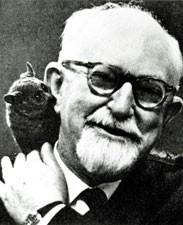
Back جورج جايلورد سيمبسون Arabic جورج جايلورد سيمبسون ARZ جورج قیلرد سیمپسن AZB George Gaylord Simpson Catalan George Gaylord Simpson Czech George Gaylord Simpson German Τζωρτζ Γκέιλορντ Σίμπσον Greek George Gaylord Simpson Esperanto George Gaylord Simpson Spanish George Gaylord Simpson Estonian
George Gaylord Simpson | |
|---|---|
 Simpson in 1965 | |
| Born | June 16, 1902 |
| Died | October 6, 1984 (aged 82) |
| Nationality | American |
| Alma mater |
|
| Known for | Modern synthesis; quantum evolution |
| Awards |
|
| Scientific career | |
| Fields | Paleontology |
| Institutions | Columbia University |
| Doctoral advisor | Richard Swann Lull[1] |
George Gaylord Simpson (June 16, 1902 – October 6, 1984) was an American paleontologist. Simpson was perhaps the most influential paleontologist of the twentieth century, and a major participant in the modern synthesis, contributing Tempo and Mode in Evolution (1944), The Meaning of Evolution (1949) and The Major Features of Evolution (1953). He was an expert on extinct mammals and their intercontinental migrations.[2] Simpson was extraordinarily knowledgeable about Mesozoic fossil mammals and fossil mammals of North and South America. He anticipated such concepts as punctuated equilibrium (in Tempo and Mode) and dispelled the myth that the evolution of the horse was a linear process culminating in the modern Equus caballus. He coined the word hypodigm in 1940, and published extensively on the taxonomy of fossil and extant mammals.[3] Simpson was influentially, and incorrectly, opposed to Alfred Wegener's theory of continental drift,[4] but accepted the theory of plate tectonics (and continental drift) when the evidence became conclusive.
He was Professor of Zoology at Columbia University, and Curator of the Department of Geology and Paleontology at the American Museum of Natural History from 1945 to 1959. He was Curator of the Museum of Comparative Zoology at Harvard University from 1959 to 1970, and a Professor of Geosciences at the University of Arizona from 1968 until his retirement in 1982.
- ^ a b c Whittington, H. B. (1986). "George Gaylord Simpson. 16 June 1902-6 October 1984". Biographical Memoirs of Fellows of the Royal Society. 32: 525–39. doi:10.1098/rsbm.1986.0017. JSTOR 770122. PMID 11621258. S2CID 31570609.
- ^ Simpson G.G. 1940. Mammals and land bridges. Journal of the Washington Academy of Sciences 30: 137–163. See Charles H. Smith's website for full text: [1]
- ^ Simpson, G. G. (1940). "Types in modern taxonomy". American Journal of Science. 238 (6): 413–426. Bibcode:1940AmJS..238..413S. doi:10.2475/ajs.238.6.413. p. 418.
- ^ Simpson G.G. 1953. Evolution and geography: an essay on historical biogeography with special reference to mammals. Oregon State System of Higher Education: Eugene, Oregon.
© MMXXIII Rich X Search. We shall prevail. All rights reserved. Rich X Search